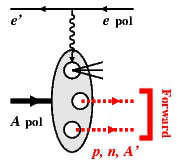Topics to be discussed:
1. Tagging for neutron structure measurements: Initial-state modifications, final-state interactions, how to separate or correct them, neutron structure extraction, polarized measurements
2. Target fragmentation of the nucleon: Physics interest, data and models, spin dependence, interplay with nuclear final-state interactions in tagged DIS
3. Short-range correlation studies with light nuclei: Probing nuclear core effects in measurements with D and 3He, observing 3N SRC in simultaneous measurements with 3He and 4He
4. Tagging for studies of nuclear quark–gluon structure: Tagged EMC effect, direct observation of non-nucleonic degrees of freedom (ΔΔ component in the deuteron, ΔNN in 3He, ...)
5. Partonic structure of light nuclei: Theoretical expectations for nuclear shadowing (leading/higher twist, gluons/quarks), antishadowing, EMC effect, spin and isospin dependence; experimental strategies
6. Coherent scattering on light nuclei: DVCS and exclusive meson production, nuclear GPDs, impact parameter dependence and quark/gluon imaging, spin effects (D Spin-1, 3He Spin-1/2, 4He Spin-0)
7. Final states in high-energy nuclear processes: Color transparency in vector meson production, inelastic diffraction from initial-state fluctuations, high-momentum breakup processes
8. EIC forward ion detection: Physics requirements, integration with optics and IR design, experience with RHIC ZDCs and Roman Pots
9. EIC simulations of processes with light nuclei: Physics models, MC generators and software tools, ongoing and planned efforts
An essential part of the program will be to discuss the results and plans in nuclear experiments at other present/future facilities, such as JLab 12 GeV, COMPASS, RHIC, LHC (including proposed fixed-target program), GSI FAIR, Dubna NIKA, J-PARC, and assess the potential synergies with EIC.

